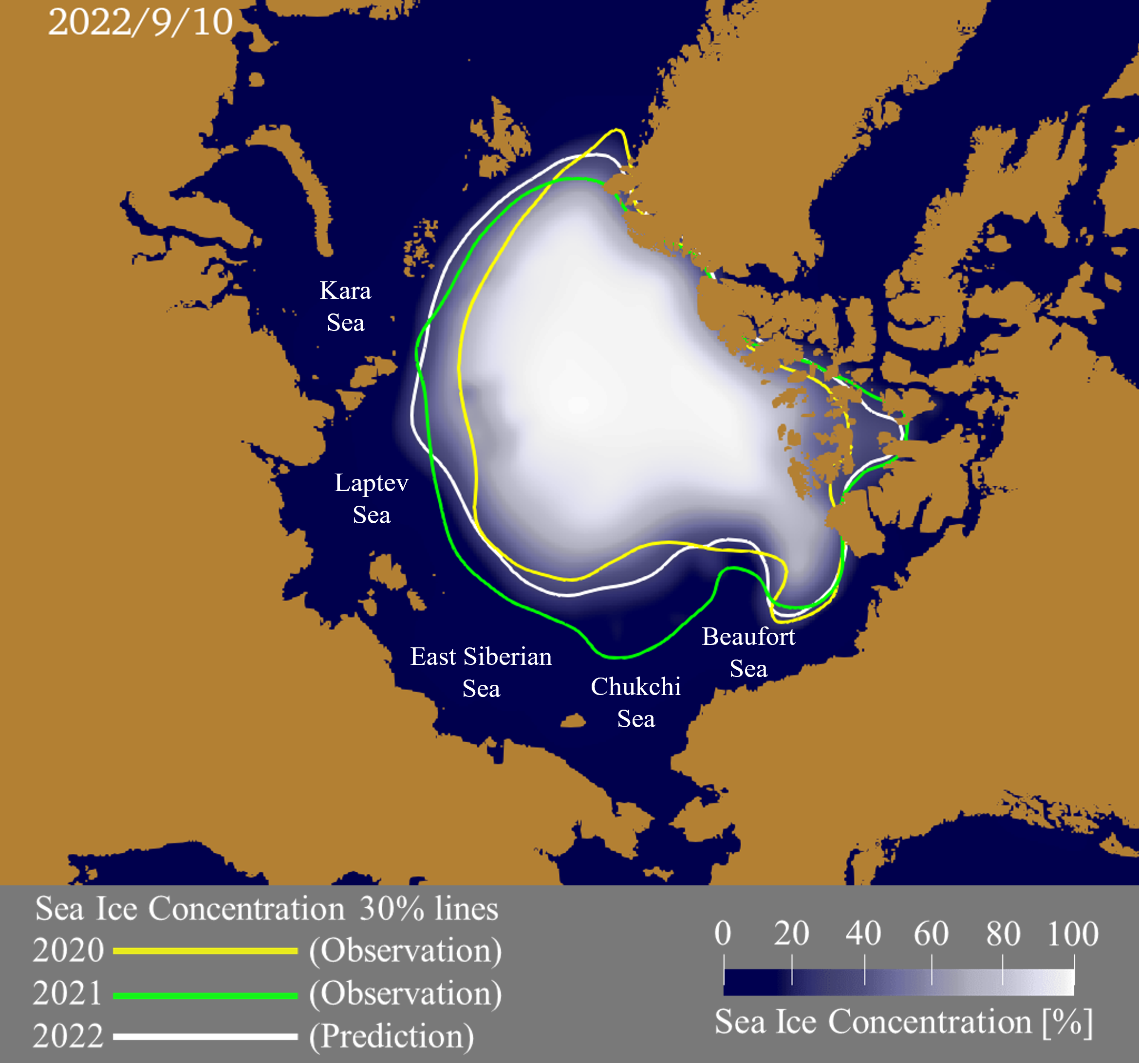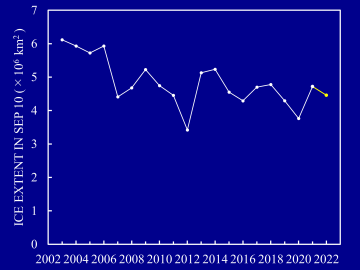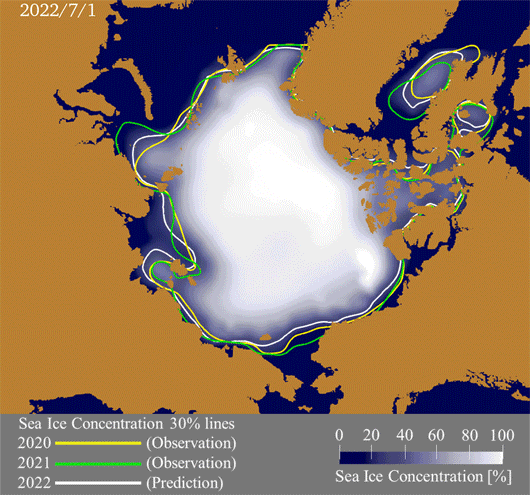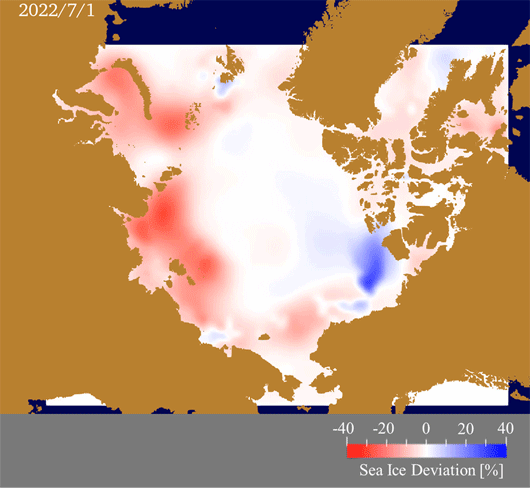2022 First report
Arctic Sea Ice Information Center, Noriaki KIMURA (Atmosphere and Ocean Research Institute, The University of Tokyo)

- Minimum ice extent will be about 4.46 million square kilometers in September. This is greater than in 2020 and less than in 2021.
- The Northern Sea Route will open around August 12, and the Canadian side except for Canadian archipelago will open around July 30.
- Sea ice will remain on the Canadian archipelago side of the Beaufort Sea.


The white line indicates the ice edge for 2022 and the colored lines for 2020 and 2021.

The predictions were based on three factors: “sea ice redistribution from winter to spring,” “sea ice age,” and “mean divergence of sea ice”. The sea ice redistribution was determined from the sea ice movement from December to the end of April, and the sea ice age was determined by the backward tracking of sea ice up to four years. The mean divergence is a new variable, representing the percentage of young ice contained.
The Arctic sea ice extent on September 10, when the sea ice minimum will be about 4.46 million square kilometers. This is greater than in 2020 and less than in 2021.
Summer Arctic sea ice extent has been declining rapidly in recent decades. While the decline was less evident between 2013 and 2019, it declined again significantly in 2020. And on September 10, 2020, the Arctic sea ice extent was 3.77 million square kilometers, the second smallest after 2012. On the other hand, in 2021, sea ice remained from the Beaufort Sea to the Chukchi Sea, and the sea ice extent on September 10 was approximately 4.72 million square kilometers, a significant increase from the previous year. This year’s sea ice extent will be slightly smaller than in 2021 but considerably larger than in 2020, indicating that the sharp decline in 2020 was transitory.
Russian side
Sea ice will retreat almost at the same time and in similar distributions in 2020 and 2021. The Northern Sea Route will open around August 12. The route opening date has been determined with some leeway, so the actual date may be a little earlier than this.
Canadian side
Sea ice from the Chukchi Sea to the Beaufort Sea will retreat at about the same time in 2020 and 2021. Sea routes of the Canadian side will open around July 30. Sea ice on the Canadian archipelago side of the Beaufort Sea will remain as it did in 2020 and 2021. This is due to the fact that old ice, more than 3 years old since its formation, is spread over this area following 2020, 2021. Therefore, it is possible that the sea ice that remains may also be thicker, and caution should be exercised.
You can also check the daily forecast on Arctic Data archive System (ADS) at National Institute of Polar Research. ADS has also started releasing sea ice age data .
Prediction method
For this prediction, we used the sea ice data from satellite microwave sensors AMSR-E and AMSR2. As noted above, three values are used in the forecast calculation. For “sea ice redistribution from winter to spring,” we estimate the location of sea ice thickening based on the movement of sea ice. The “sea ice age” is determined by tracing the position of particles placed on the sea ice back several years and identifying the date of sea ice formation. Please refer to the 2018 First report and the 2021 Third report complement for the prediction method up to last year.
In last year’s third report, we added sea ice age as a variable, but it was difficult to predict that sea ice would remain sparse from the Chukchi Sea to the Beaufort Sea. This may be due to the fact that the effects of the old multi-year ice were not well taken into prediction. In this prediction, we added the mean divergence of sea ice to our calculations. Past examples suggest that the relationship between sea ice age and ice melting speed is not simple, and that adding divergence would allow for more realistic predictions.
The greater the divergence, the more gaps (open water area) are created between the sea ice, where new sea ice is formed. Divergence values are calculated by tracking installed particles. The mean divergence value is the accumulated value of divergence divided by the number of days. The larger this value is, the thinner sea ice will be mixed in with the thicker ice areas, and also the thinner the sea ice will be on average.
The following regression equation was used to predict.
\begin{align*}
(SIC’)^{n}_{i,j} = a \cdot{} P^{n}_{i,j} + b \cdot{} (SIA)^{n}_{i,j} + c \cdot{} (DIV)^{n}_{i,j} + d
\end{align*}
$SIC’$is the deviation from the linear trend of sea ice concentration obtained from the regression equation, $P$ is the density of particles calculated from the redistribution of sea ice from winter to spring, $SIA$ is the sea ice age, $DIV$ is the mean divergence value of sea ice, $n$ is the year, $i,j$ are the coordinates of grid points, and $a,b,c,d$ are coefficients to determine the regression equation. These coefficients are obtained by the least squares method. (Please refer to the 2021 Third report complement for detailed explanation on obtaining the coefficients.) The value obtained here is added to the value predicted by the linear trend of sea ice sea ice concentration to obtain the final sea ice concentration.
The data used in the calculations are for the years 2007-2011 and 2016-2021. There is a blank period due to the observation gap between AMSR-E and AMSR2. Four years of data is required to estimate the sea ice age, and predictions can be made four years after the observation data is acquired.
If you have any questions about satellite monitoring of the Arctic Ocean, sea ice forecasting, or the forecasting methods used here, please contact the Arctic Sea Ice Information Center(sea_ice@nipr.ac.jp)
The sea ice forecast and its basic research were started in GRENE, continued to ArCS Project, and has been conducted in ArCS II Project since 2020.


